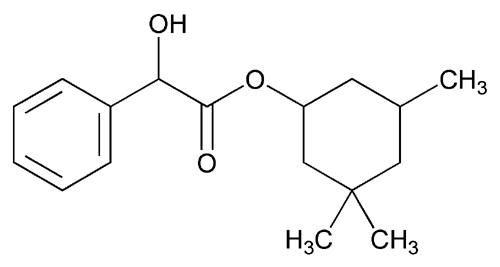Cyclandelate
» Cyclandelate contains not less than 98.0 percent of C17H24O3, calculated on the dried basis.
Packaging and storage—
Preserve in tight, light-resistant containers, and store below 40 , preferably between 15
, preferably between 15 and 30
and 30 .
.
Identification—
A:
Ultraviolet Absorption  197U
197U —
—
Solution:
0.5 mg per mL.
Medium:
95% alcohol.
The solution exhibits absorption maxima between 250 and 254 nm, between 256 and 260 nm, and between 262 and 266 nm.
B:
Thin-Layer Chromatographic Identification Test  201
201 —
—
Test solution—
Dissolve 10 mg of Cyclandelate in 1 mL of alcohol.
Application volume:
5 µL.
Developing solvent system:
a mixture of hexane, ethyl acetate, and glacial acetic acid (8:2:1).
Loss on drying  731
731 —
Dry 1 g over silica gel for 24 hours: it loses not more than 0.5% of its weight.
—
Dry 1 g over silica gel for 24 hours: it loses not more than 0.5% of its weight.
Residue on ignition  281
281 :
not more than 0.1%.
:
not more than 0.1%.
Heavy metals, Method II  231
231 :
0.002%.
:
0.002%.
Chromatographic purity—
Mobile phase and Chromatographic system—
Prepare as directed in the Assay.
Test solution—
Transfer about 100 mg of Cyclandelate, accurately weighed, to a 100-mL volumetric flask, dissolve in and dilute with Mobile phase to volume, and mix.
Standard solution—
Pipet 3.0 mL of the Test solution into a 100-mL volumetric flask, dilute with Mobile phase to volume, and mix.
Procedure—
Separately inject equal volumes (about 10 µL) of the Test solution and the Standard solution into the chromatograph, record the chromatograms, and measure the areas for all the peaks. Allow the chromatogram of the Test solution to run for a period of time that is about 3 times the retention time of cyclandelate. The total area of all the peaks from the Test solution, other than the peak obtained from cyclandelate, is not greater than the peak area of cyclandelate obtained from the Standard solution: not more than 3.0% of total impurities is found.
Assay—
Mobile phase—
Prepare a filtered and degassed mixture of acetonitrile and water (4:1). Make adjustments if necessary (see System Suitability under Chromatography  621
621 ).
).
Resolution solution—
Dissolve accurately weighed quantities of USP Cyclandelate RS and dicyclohexyl phthalate in Mobile phase to obtain a solution having known concentrations of about 0.2 mg per mL and 0.08 mg per mL, respectively.
Standard preparation—
Dissolve an accurately weighed quantity of USP Cyclandelate RS in Mobile phase to obtain a solution having a known concentration of about 1.0 mg per mL. Pipet 10.0 mL of this solution into a 50-mL volumetric flask, dilute with Mobile phase to volume, and mix.
Assay preparation—
Transfer about 100 mg of Cyclandelate, accurately weighed, to a 100-mL volumetric flask, dissolve in and dilute with Mobile phase to volume, and mix. Pipet 10.0 mL of this solution into a 50-mL volumetric flask, dilute with Mobile phase to volume, and mix.
Chromatographic system (see Chromatography  621
621 )—
The liquid chromatograph is equipped with a 228-nm detector and a 4.0-mm × 15-cm column that contains packing L1. The flow rate is about 1.0 mL per minute. Chromatograph the Resolution solution, and record the peak responses as directed for Procedure: the resolution, R, between cyclandelate and dicyclohexyl phthalate is not less than 7. Chromatograph the Standard preparation, and record the peak responses as directed for Procedure: the relative standard deviation for replicate injections is not more than 2.0%.
)—
The liquid chromatograph is equipped with a 228-nm detector and a 4.0-mm × 15-cm column that contains packing L1. The flow rate is about 1.0 mL per minute. Chromatograph the Resolution solution, and record the peak responses as directed for Procedure: the resolution, R, between cyclandelate and dicyclohexyl phthalate is not less than 7. Chromatograph the Standard preparation, and record the peak responses as directed for Procedure: the relative standard deviation for replicate injections is not more than 2.0%.
Procedure—
Separately inject equal volumes (about 10 µL) of the Standard preparation and the Assay preparation into the chromatograph, record the chromatograms, and measure the areas for the major peaks. Calculate the quantity, in mg, of C17H24O3 in the portion of Cyclandelate taken by the formula:
500C(rU / rS)
in which C is the concentration, in mg per mL, of USP Cyclandelate RS in the Standard preparation; and rU and rS are the peak responses obtained from the Assay preparation and the Standard preparation, respectively.
Auxiliary Information—
Please check for your question in the FAQs before contacting USP.
Chromatographic Column—
| Topic/Question | Contact | Expert Committee |
| Monograph | Sujatha Ramakrishna, Ph.D.
Scientist 1-301-816-8349 |
(MDCV05) Monograph Development-Cardiovascular |
| Reference Standards | Lili Wang, Technical Services Scientist 1-301-816-8129 RSTech@usp.org |
USP32–NF27 Page 2037
Pharmacopeial Forum: Volume No. 30(6) Page 1985
Chromatographic columns text is not derived from, and not part of, USP 32 or NF 27.

